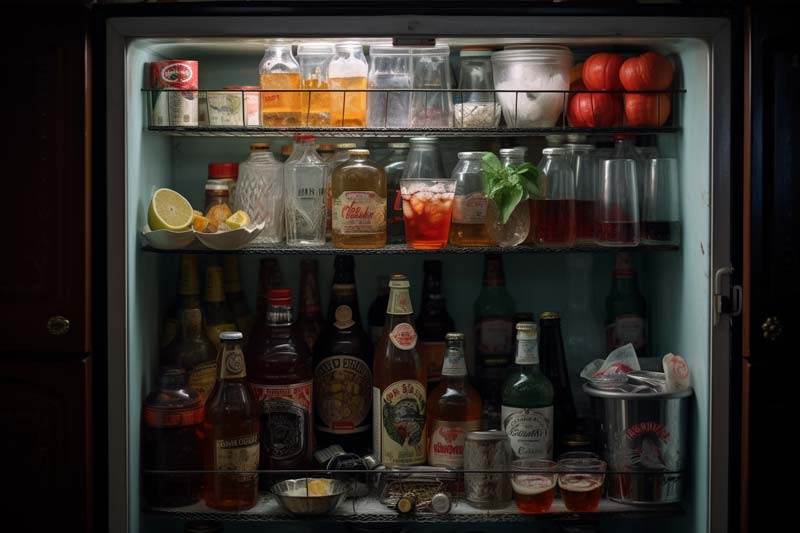Picture this: you stand before the majestic doors of your wine fridge, ready to embark on a tasting journey that will traverse the flavors and complexities of various wine types.
But before you open those doors, my fellow oenophiles, let’s discuss an important detail: the optimal storage temperature for different wine types in your wine fridge.
You see, finding that perfect temperature sweet spot is the key to ensuring that each bottle reaches its full potential, allowing you to savor the unique characteristics and nuances of every wine type.
So, grab your corkscrew and your sense of adventure, as we explore the secrets to optimizing your wine fridge storage temperature for the ultimate tasting experience.
Table of Contents
Reds: Not Too Hot, Not Too Cold

Ah, the bold and robust world of red wines – a realm filled with deep flavors, rich aromas, and the promise of indulgence.
But when it comes to finding the ideal red wine storage temperature, it’s all about balance, my friends.
You want to find that sweet spot where the wine can develop and mature, while still maintaining its vibrancy and freshness.
Mastering Cab and Merlot Wine Serving Temperatures
For full-bodied reds like Cabernet Sauvignon or Merlot, aim for a storage ideal temperature to degrees range of around 55°F to 60°F (12°C to 15°C).
This slightly cooler temperature helps to preserve the wine’s structure and allows its flavors to develop harmoniously.
The tannins remain balanced, the fruit flavors shine, and the wine exhibits its true character.
Avoid storing these reds at higher temperatures, as it can result in a less-than-pleasant experience, with the alcohol overpowering the flavors and the wine losing its finesse.
Remember, my friends, red wines are like a fine dance – they need space to breathe and develop, but not too much.
By finding that sweet spot in your wine fridge, you can ensure that your full-bodied reds age gracefully and deliver peak enjoyment with every sip.
Whites: Varietals Want What They Want
Now, let’s turn our attention to the refreshing and vibrant world of white wines.
With their crisp acidity and delicate flavors, white wines require a slightly different storage temperature than their red counterparts.
Crisp or Zach? Each Has Its Spot
For crisp and vibrant whites like Sauvignon Blanc or Pinot Grigio, aim for a wine fridge temperature range of around 45°F to 50°F (7°C to 10°C).
This cooler temperature enhances the wine’s refreshing qualities, preserving its bright acidity and zesty flavors.
These wines thrive in a slightly chillier environment, allowing their citrus notes to sing and their floral aromas to bloom.
On the other hand, for richer and fuller-bodied whites like Chardonnay or Viognier, a temperature to store range of around 50°F to 55°F (10°C to 13°C) is ideal.
This slightly warmer temperature allows these whites to express their complexity and showcases their buttery texture.
The flavors become more pronounced, and the wine provides a richer and more luscious experience.
By catering to the specific storage temperature needs of each white wine varietal, you can unlock its true potential and enjoy a sensory journey through delicate aromas and refreshing flavors.
Bubbly: Cool It, Don’t Freeze Pop It
Now, let’s venture into the effervescent realm of sparkling wines, a category that includes champagne, prosecco, and other delightful sparkling delights.
Chilled bubbles are a symbol of celebration and joy, but finding the perfect storage temperature is vital to preserve their vibrancy and ensure a memorable experience.
Champagne Deserves Just the Right Chill
For champagne and other sparkling wines, a storage temperature range of around 45°F to 50°F (7°C to 10°C) is recommended.
This slightly cooler temperature keeps the bubbles lively and prevents the wine from becoming overly frothy or losing its delicate effervescence.
Avoid storing sparkling wines at temperatures that are too cold, as it can dull the flavors and impact the overall drinking experience.
Remember, my friends, when it comes to bubbly, it’s all about finding that delicate balance between cool and refreshing.
Fortified: Not Your Grandma’s Sherry Fridge.

Now, let’s explore the fortified world of wines, where higher alcohol content and complex flavors take center stage.
Fortified wines, such as port and madeira, require a slightly different storage temperature to reach their optimum taste.
Port and Madeira Want Moderate
For ports and madeiras, a storage temperature range of around 55°F to 60°F (12°C to 15°C) is recommended.
This moderate temperature allows these wines to develop their unique characteristics and showcase their depth of flavors.
Avoid storing fortified wines at excessively cool temperatures, as it can hinder their aging process and mute their complexity.
By providing an environment with just the right temperature, you can ensure that your fortified wines retain their distinctive qualities and deliver a rich and satisfying tasting experience.
Dessert: Sweet Sensations Need Sweeter Care
Lastly, let’s raise our glasses to the luscious and indulgent world of dessert wines.
Their rich sweetness demands specific storage temperature conditions to maintain their viscosity and preserve their delightful flavors.
Ice Wine Is a Whole Other Ballgame
For dessert wines like late harvest Riesling or Sauternes, a slightly cooler storage temperature range of around 45°F to 50°F (7°C to 10°C) is recommended.
This cooler temperature keeps the wine’s sweetness in balance and ensures that it maintains its luscious and honeyed qualities.
However, ice wines, which are made from grapes that have been frozen on the vine, need an even chillier temperature.
For ice wines, aim for a storage temperature range of around 35°F to 40°F (2°C to 5°C) to preserve their concentrated sweetness and prevent the wine from becoming too syrupy.
By providing the ideal storage temperature for your dessert wines, you can unlock their full potential and savor their decadent and indulgent qualities.
As our exploration of optimal wine fridge storage temperature for various wine types comes to a close, I hope you now possess the knowledge and confidence to curate the perfect environment for your diverse collection.
Remember, my dear oenophiles, the art of temperature is a powerful tool that can elevate your wine tasting experience and unlock a world of flavors and aromas with every bottle.
Wine is a living entity, and it deserves to be stored and served in conditions that allow it to flourish and provide the ultimate drinking experience.
Cheers to the perfect temperature and the unending delights that await within each glass!
What temperature should wine be stored at in a wine fridge?
The optimal storage temperature for wine in a wine fridge depends on the type of wine. In general, red wines are best stored at temperatures between 55°F and 60°F (12°C to 15°C), while white wines thrive at slightly cooler temperatures of around 45°F to 50°F (7°C to 10°C).
Is 40 degrees too cold to store wine?
Yes, 40 degrees Fahrenheit (4 degrees Celsius) is considered too cold to store wine for an extended period. While it may not immediately spoil the wine, storing wine at such a low temperature can slow down the aging process and mute the flavors. It’s best to aim for a temperature range that allows the wine to develop and express its full potential.
What temperature is too cold for wine storage?
Generally, temperatures below 45°F (7°C) can be considered too cold for wine storage. Extreme cold temperatures can disrupt the aging process and affect the wine’s flavors and aromas. It’s important to find a range where the wine can mature and evolve while still maintaining its vibrancy and complexity.
What temperature is best for wine storage?
The best storage temperature for wine depends on the type of wine. As a general rule, a temperature range of 55°F to 60°F (12°C to 15°C) is ideal for red wines, while white wines benefit from slightly cooler temperatures of around 45°F to 50°F (7°C to 10°C). It’s important to remember that these temperatures are guidelines, and personal preferences may vary. The key is to find a range that allows the wine to age gracefully and showcase its unique characteristics.